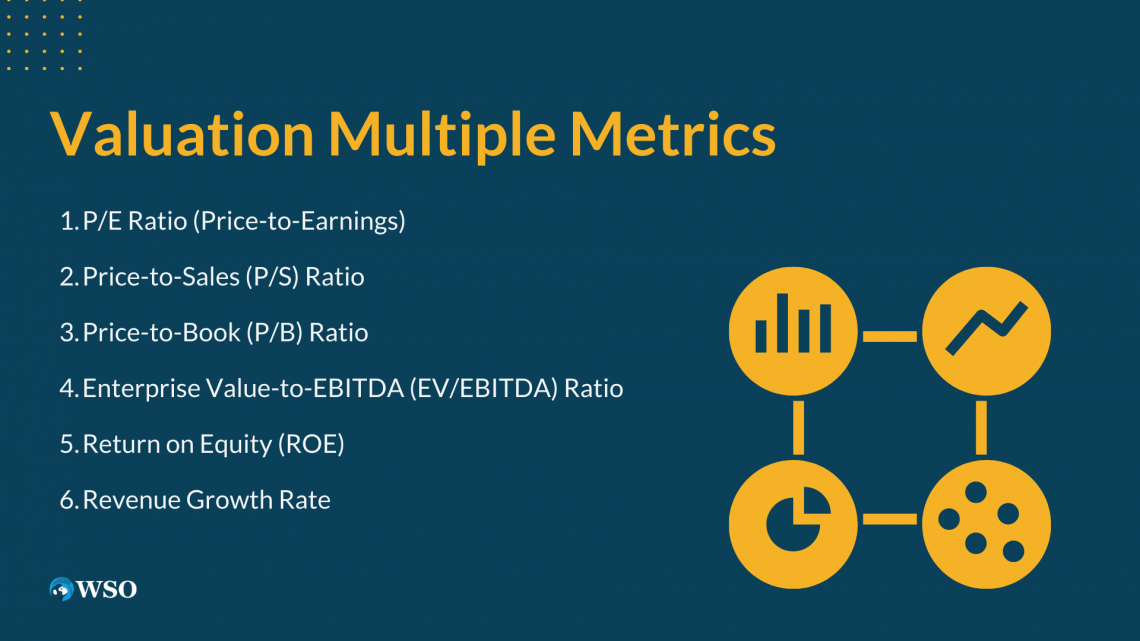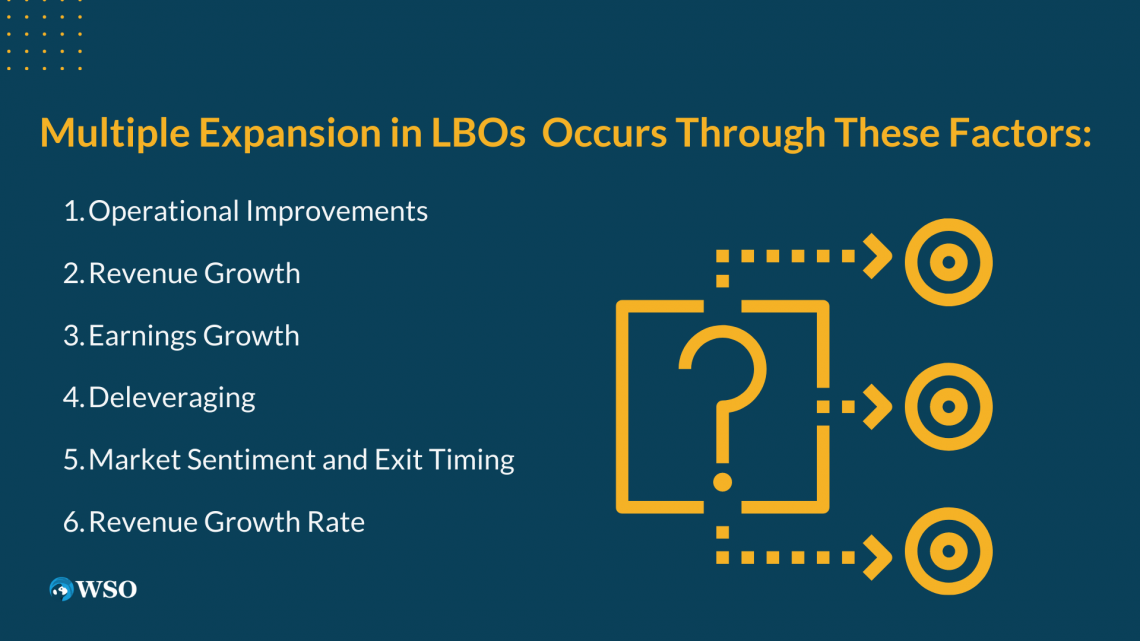Multiple Expansion
When an investor sells an asset for an exit price higher than the price they purchased, it is called multiple expansion
When an investor sells an asset for an exit price higher than the price they purchased it for, it is called multiple expansion.

It is a favorable outcome to sell something higher than what it was bought for, and it is a commonly used investment strategy that many investors of many types of asset classes use.
Multiple expansion is a form of arbitrage, which is a strategy for trading assets in different markets or derivative forms to take advantage of price differences.
It is important to know that buying low and selling high always comes with luck, and investors cannot dictate a market to move in their favor.
The term is generally used for private equity, where a company buys a company and subsequently sells it at an increased price.
In other words, in a private equity deal, if the exit multiple is more significant than the entry multiple, the process can be called multiple expansion.
In this article, you’ll learn what a multiple is, how to use it, and many instances where the term multiple expansion can be used.
Key Takeaways
- When an investor sells an asset for a higher price than the purchase price- we call this multiple expansion. It is a common investment strategy used across various asset classes.
- Buying low and selling high is a general strategy most investors follow, including those trading stocks, options, real estate, cryptocurrency, bonds, and foreign exchange markets.
- Multiple expansions in private equity deals are common, where a company is acquired by another company and subsequently sold at a higher price.
- Valuation multiples are quantitative values used in finance for valuation purposes. They represent values derived by dividing one metric by another and are used to assess a company's value and potential investment opportunities.
- Multiple expansion occurs when the exit multiple (valuation) exceeds the entry multiple. It is considered a favorable outcome, indicating a positive result for the investment. Conversely, multiple contractions occur when the exit multiple is lower than the entry multiple.
What Is a Multiple?
A multiple is a quantitative value used in finance for valuation purposes. A multiple is usually derived from dividing one number by another.

As a multiple is typically set up to be a whole number, we can also say that the numerator is typically larger than the denominator.
Note
A multiple can be referred to as a valuation multiple because it can be used in the process of valuing a company. The EV/EBITDA multiple can represent this.
For example, we could say that a private equity firm bought a company with an entry multiple of 12x. In this case, the 12x value is derived from a simple quotient.
Let's say that the company’s enterprise value is 120 million, and its EBITDA is 10 million.
We divide the company’s total enterprise value by the company’s EBITDA to find the EV/EBITDA multiple.
With all valuation multiples, we can use this general formula:
Valuation Multiple = (Value Measure)/ (Value Driver)
Or
Valuation Multiple= (Enterprise Value or Equity Value) / (EBITDA, EBIT, revenue, etc.)
In this case, the calculation would be:
120 million/ 10 million = 12x
For now, all you need to know is that multiples represent values where one metric is divided by another (such as rice-to-earnings, P/E). These multiples can be compared between multiple companies to assess value and potential investment opportunities.
There are many types of multiples with many different metrics in finance.
Multiple Expansion Vs. Multiple Contraction
Multiple expansion is determined after finding the entry multiple and exits multiple. If the exit multiple ends up being higher than the entry multiple, it is called multiple expansion.

Let’s look at an example of this situation.
Let’s say that a private equity company buys an energy company with an enterprise value of $500 million and an EBITDA of 150. The multiple in this case would be 4, using the methods of calculation that we demonstrated previously.
Here is a demonstration of this calculation.
500 million/ 150 million = 4x
Now, ten years later, the private equity firm is selling this energy company. Now, this company has an enterprise value of $900 million and an EBITDA of 180. This multiple is now 5, which means that multiple expansion has occurred.
Here is the calculation.
900 million/ 180 million = 5x
Multiple contractions are the opposite when the entry multiple is higher than the exit multiple.
For example, let’s imagine a private equity firm purchases a healthcare company with an enterprise value of $100 million and an EBITDA of 10 million. This means that the entry multiple would be 10.
Here is the calculation.
900 million/ 180 million = 10x
Several years later, they decided to sell the company when it had an enterprise value of $100 million and an EBITDA of 20. The multiple is now 5.
Here is the calculation.
100 million/ 20 million = 5x
Since the exit multiple was a smaller value than the initial multiple upon the company's purchase, we can call this multiple contraction or multiple compression. It is considered a positive sign, and it is correlated with the overall outcome of the deal.
Valuation Multiple Metrics
More expansion can occur for various reasons, such as growth prospects, improved economic growth, or a positive market environment and outlook.

While no specific formulas are used exclusively for multiple expansions, several key metrics are often considered when assessing a company’s value and potential for multiple expansions.
These ratios include:
1. P/E Ratio (Price-to-Earnings)
This ratio compares a company’s current stock trading price to its earnings per share (EPS).
In interpretation, the ratio tells us how much investors are willing to pay for each dollar of earnings.
A higher P/E ratio can indicate market optimism and potential for multiple expansion, especially if the company's earnings are expected to grow. However, a high P/E ratio also indicates potential overvaluation.
2. Price-to-Sales (P/S) Ratio
The P/S ratio compares a company's most recent stock price to its revenue per share.
In interpretation, the P/S ratio tells us how much investors are willing to pay for each dollar of sales the company generates.
A higher P/S ratio can indicate expectations of strong revenue growth and potential for multiple expansions.
3. Price-to-Book (P/B) Ratio
The P/B ratio compares two elements of a company in a very meaningful ratio.
Specifically, it compares a company's stock price to its book value per share (BVPS). BVPS uses the company’s book value, which is one way to estimate a company’s worth.
Note
Book value is simply a company’s assets minus its liabilities or how much it is worth after paying its debt obligations.
For the ratio of price-to-book value, we take the company’s most recent stock price and divide it by the book value per share, which can be calculated by dividing the book value by the total number of shares.
The P/B ratio tells us the price of the company's assets relative to its market cap.
A higher P/B ratio may indicate the market's expectation of future growth and potential for multiple expansion. However, like the P/E ratio, it could mean overvaluation and should be carefully considered in its specific industry with other financial metrics.
4. Enterprise Value-to-EBITDA (EV/EBITDA) Ratio
The EV/EBITDA ratio compares a company's enterprise value to its earnings.
It is commonly used in valuation analysis, especially for companies with significant debt or varying levels of depreciation and amortization. A lower EV/EBITDA ratio relative to peers may suggest the potential for multiple expansion.
5. Return on Equity (ROE)
ROE measures a company's profitability relative to its shareholders' equity. Higher ROE indicates efficient use of capital and strong profitability, which can positively correlate with multiple expansion if sustained.
6. Revenue Growth Rate
A percentage increase in revenue over a certain period of time. Companies with consistently high revenue growth rates may be more likely to experience multiple expansion.
There are many common uses of it and variations of how each ratio can be interpreted in financial analysis. Next, we will focus on multiple expansion in PE LBOs (private equity leveraged buyouts).
Multiple Expansion In Leveraged Buyouts
In the case of leveraged buyouts (LBOs), it refer to an increase in a company’s valuation level during the private equity leveraged buyout.

Private equity firms achieve expansion in the valuation multiple of a company by acquiring companies as assets using debt financing, with the aim that they will improve efficiency, reduce costs, and increase profitability to maximize return on investment.
Multiple expansion in LBOs typically occurs through factors such as:
1. Operational Improvements
Private equity firms often focus on implementing operational enhancements and efficiency measures within the acquired company.
These can include cost-cutting initiatives, supply chain optimizations, process improvements, and strategic repositioning. As the company's financial performance improves, its valuation multiple may expand.
2. Revenue Growth
Private equity firms may work to drive revenue growth by exploring new markets, expanding the company's product or service offerings, enhancing sales and marketing efforts, or pursuing strategic acquisitions.
Note
Strong revenue growth can lead to higher valuations and multiple expansion.
3. Earnings Growth
LBOs aim to enhance a company's earnings through various means, such as improving profit margins, implementing pricing strategies, reducing working capital requirements, and streamlining operations. As earnings improve, the valuation multiple may expand.
4. Deleveraging
LBO transactions often involve significant debt financing, and one of the primary goals for private equity firms is to reduce the company's debt burden over time.
As the company pays down debt and improves its financial health, investor confidence increases, which can result in multiple expansion.
5. Market Sentiment and Exit Timing
Favorable market conditions and investor sentiment can also influence multiple expansion.
Private equity firms often aim to exit their investments during periods of positive market sentiment, where they can achieve higher valuations for the company due to increased demand from potential buyers.
Here are some ways that companies can directly impact the possibility of achieving multiple expansion on an LBO:
- Closing unnecessary facilities
- Eliminating unnecessary work
- Reducing employee headcount
- Negotiating client contracts
- Focusing on specific customer territories and groups
Since the whole goal behind achieving multiple expansion is to buy low and sell high, these tactics help improve efficiency and profitability.
In turn, it helps the company take steps to become more expensive in the future.




or Want to Sign up with your social account?